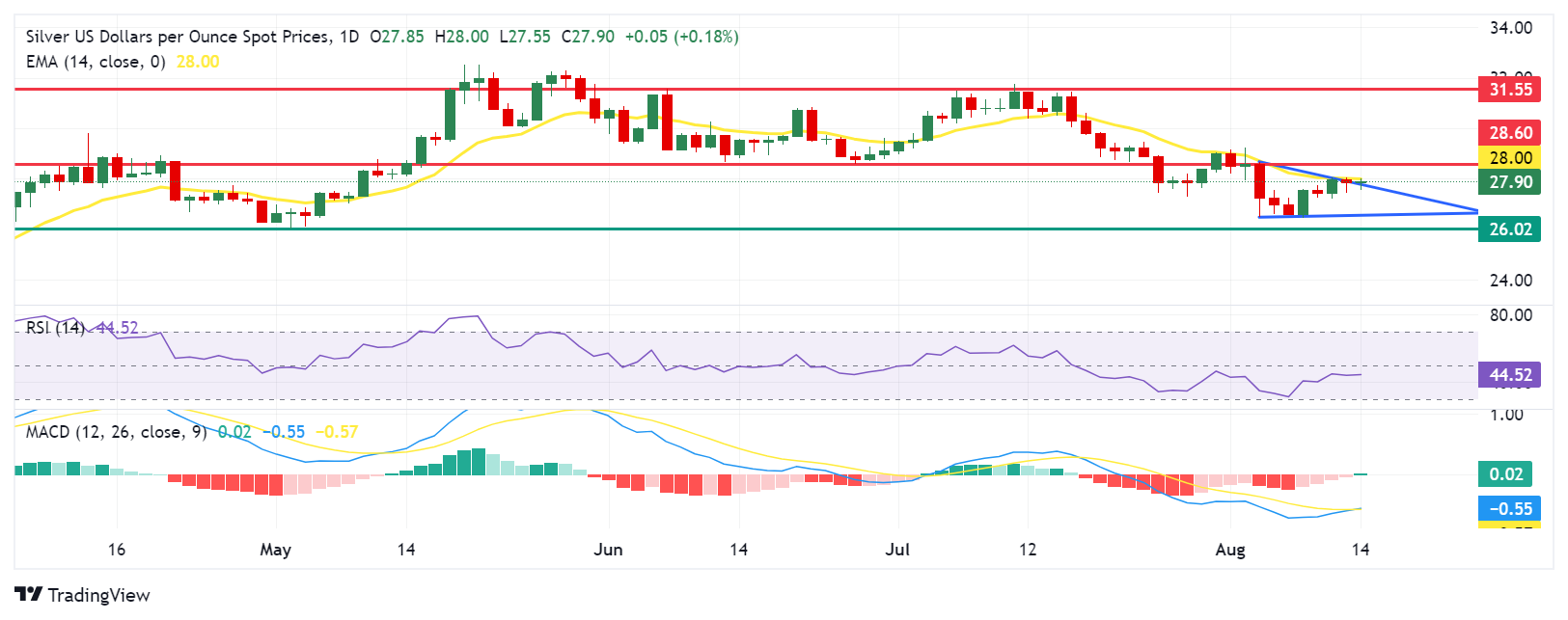- Silver price is facing immediate resistance around the 14-day EMA at $28.00.
- Analysis of the daily chart indicates a breakout above a descending triangle, which suggests a possible trend reversal to the upside.
- The upper boundary of the descending triangle around the $27.75 mark serves as immediate support.
Silver price (XAG/USD) is giving up recent gains and is trading around $27.90 per troy ounce during the European session on Wednesday. Analysis of the daily chart shows a breakout above a descending triangle pattern, which is considered a positive signal. This breakout suggests that the market may be shifting from a bearish to a bullish bias.
Moreover, the 14-day Relative Strength Index (RSI) is consolidating below the 50 level, indicating a downtrend. A break above the 50 level would indicate the formation of an uptrend.
In addition, the Moving Average Convergence Divergence (MACD) line has crossed above the signal line, indicating a potentially bullish signal. However, since both lines remain below the midline (zero line), this suggests that the overall trend is still bearish. It might be wise to wait for further confirmation before making any important trading decisions.
In terms of support, silver price is testing the upper boundary of the descending triangle around the $27.75 level. A return to the descending triangle would reinforce the bearish bias and push the metal asset to navigate the region around the $26.60 level, followed by the May low at $26.02.
On the upside, silver price is testing an immediate resistance around the 14-day exponential moving average (EMA) at the $28.00 level, followed by the “fallback support turned resistance” at the $28.60 level. A break above the latter could prompt the XAG/USD pair to explore the region around the two-month high at the $31.75 level.
XAG/USD: Daily Chart

Frequently asked questions about silver
Silver is a precious metal that is widely traded among investors. It has historically been used as a store of value and a medium of exchange. Although it is less popular than gold, traders can turn to silver to diversify their investment portfolio, for its intrinsic value or as a potential hedge in times of high inflation. Investors can buy physical silver in coins or bars, or trade it through instruments such as exchange-traded funds that track its price on international markets.
The price of silver can change based on a variety of factors. Geopolitical instability or fear of a severe recession can drive up the price of silver due to its safe-haven status, although to a lesser extent than gold. As a non-yielding investment, silver tends to rise when interest rates are lower. Its movements also depend on how the U.S. dollar (USD) behaves, as the asset is valued in dollars (XAG/USD). A strong dollar tends to keep the price of silver in check, while a weaker dollar is likely to drive prices higher. Other factors such as investment demand, mining supply—silver is much more common than gold—and recycling rates can also affect prices.
Silver is widely used in industry, especially in areas such as electronics or solar energy, because it has one of the highest electrical conductivities of any metal – higher than copper and gold. A surge in demand can raise prices, while a decline tends to lower them. The dynamics of the US, Chinese and Indian economies can also contribute to price fluctuations: in the US and especially in China, silver is used in various processes in major industries; in India, consumer demand for the precious metal for jewelry also plays an important role in pricing.
Silver prices tend to follow the movements of gold prices. When gold prices rise, silver usually follows the trend as they share a similar status as safe haven assets. The gold/silver ratio, which indicates the number of ounces of silver required to equal the value of one ounce of gold, can help determine the relative value of both metals. Some investors consider a high ratio to be an indicator that silver is undervalued or gold is overvalued. On the contrary, a low ratio could indicate that gold is undervalued compared to silver.

